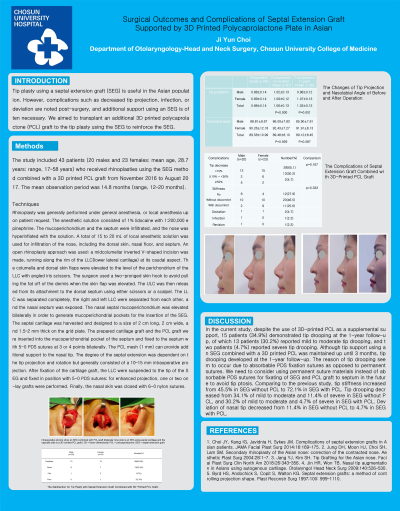Facial Plastic and Reconstructive Surgery
(531) Usefulness of Rhinoplasty Using 3D Printed Polycaprolactone Plate in Asian
Monday, October 2, 2023
2:45 PM - 3:45 PM East Coast USA Time

Has Audio

Ji Yun Choi, MD
Professor
Chosun University Hospital
Gwangju, Kwangju-jikhalsi, Republic of Korea
Presenting Author(s)
Disclosure(s):
Ji Yun Choi, MD: No relevant relationships to disclose.
Introduction: Tip plasty using a septal extension graft (SEG) is useful in the Asian population. However, complications
such as decreased tip projection, infection, or deviation are noted post-surgery, and additional support using an SEG is often
necessary. We aimed to transplant an additional 3D printed polycaprolactone (PCL) graft to the tip plasty using the SEG to
reinforce the SEG.
Methods: The study included 43 patients (20 males and 23 females; mean age, 28.7 years; range, 17–58 years) who
received rhinoplasties using the SEG method combined with a 3D printed PCL graft from November 2016 to August 2017. The
mean observation period was 14.8 months (range, 12–20 month
Results: Twenty-six patients rated their satisfaction level as excellent, 13 rated good, 3 rated fair, and 1 rated poor. In
total, 28 patients did not exhibit tip drooping at the 1-year follow-up; 13 patients demonstrated mild to moderate tip drooping,
and 2 patients demonstrated severe tip drooping. Thirty-one patients demonstrated “stiffness” of the nasal tip, of which
11 patients reported discomfort, and 20 patients reported none; two patients demonstrated deviation of the tip.
Conclusions: The main problem of tip plasty arises in Asians when
not enough cartilage is used to raise the nasal tip, or if it is
too weak; in these cases, it is difficult to raise the nasal tip
sufficiently.
A 3D-printed PCL graft to the tip plasty using an SEG
to reinforce the SEG and provide additional support to the
tip, as well as strengthening and straightening support to
the SEG was proposed in this study. However, care needs
to be taken to prevent complications such as tip stiffness,
tip drooping, deviation, extrusion, and infection. Therefore,
a PCL graft designed by a 3D printing method can serve as
a biocompatible, rhinoplastic, and facial plastic material in
the future.
